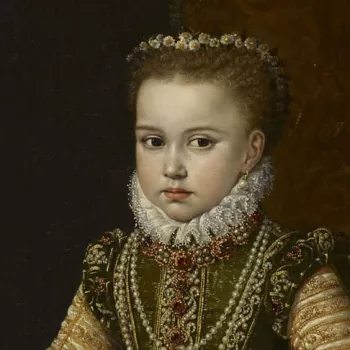King Ferdinand V of Spain, King of Aragon (1452-1516) c. 1470-1520
Oil on panel | 37.35 x 27.0 cm (support, canvas/panel/stretcher external) | RCIN 403448

Spanish School, 15th century
King Ferdinand V of Spain, King of Aragon (1452-1516) c. 1470-1520
-
This portrait is one of a pair showing Ferdinand II of Aragon (1452-1516) and his wife, Isabella I of Castile (1451-1504), King and Queen of Spain and parents of Katherine of Aragon (1485-1536). The paintings were first recorded in the Royal Collection during the reign of Henry VIII; however, it is possible that the they came to England at the time of Katherine's marriage to Prince Arthur, Henry's elder brother or were sent as diplomatic gifts during the negotiations for the match.
The marriage in 1469 of Ferdinand II of Aragon and his cousin Isabella I of Castile united their kingdoms and transformed Spain into a major European power, paving the way for unification under their grandson, Holy Roman Emperor Charles V. During their joint reign, Ferdinand and Isabella expanded their territories, financing Christopher Columbus in his 1492 voyage, which resulted in discovery of the Americas. For their fervent defense of the Catholic faith, they were proclaimed 'The Catholic Kings' by Pope Alexander VI.
This portrait shows King Ferdinand in three-quarters against a blue background, wearing a richly embroidered surcoat of cloth of gold, open at the neck to show the white shirt beneath. He wears a heavy gold chain and a black cap. As in the portrait of Queen Isabella, Ferdinand has been painted before a stone sill; however, unlike his wife who is seen holding a book, the hands of the King are not visible.
This portrait is one of several versions of this compostion. In a portrait in the collection of the Society of Antiquaries, London, the King is shown wearing a similar cloth of gold surcoat and cap before a stone sill. However, in this portrait he is shown against a red background, wearing a cross rather of a gold chain and his hands are in view. A further three portraits are located respectively in the Kunsthistorisches Museum, Vienna, the Musee Rupert de Chievres in Poitiers and at Grimsthorpe Castle, Lincolnshire. The former is similar in composition to the Royal Collection portrait, although Ferdinand wears a red or orange surcoat and is shown against a brown background. In the other two paintings he wears a plain black robe and in the Grimsthorpe Castle painting, again Ferdinand's hands are visible and a cross adorns the chain around his neck. Of these four paintings, only the Society of Antiquaries portrait has a rounded head and painted sill as in the Royal Collection version.
Unlike other known versions of the portrait, the Royal Collection painting is paired with a portrait of Isabella of Castile (RCIN 403445). In it, the Queen is shown in three-quarters against a blue background, wearing a richly embroidered dress made from the same cloth of gold seen in the portrait of her husband. The stone sill is also visible, on which Queen Isabella rests a book. Mid-twentieth century conservation examination revealed both paintings to be round-headed and of exactly the same size. It is probable therefore that the portraits were painted as a pair by the same artist, although it is not currently possible to say who that artist was.
The painting appears in Pyne's illustrated 'Royal Residences' of 1819, hanging in The Old Drawing Room at Kensington Palace (RCIN 922153).Provenance
First recorded in the collection of Henry VIII at Whitehall in 1542 (no 800); in the Privy Gallery in 1639 (no 50); probably one of the '31 pictures of Kings and princes' sold for £20 to de la Mare on 28 June 1650 from St James's Palace (no 218); recovered at the Restoration and back in the King's Privy Gallery at Whitehall in 1666 (no 120)
-
Creator(s)
-
Medium and techniques
Oil on panel
Measurements
37.35 x 27.0 cm (support, canvas/panel/stretcher external)
Category
Object type(s)
Alternative title(s)
King Ferdinand of Aragon (1452-1516), King Ferdinend V of Spain
Ferdinand of Aragon (1452-1516)








